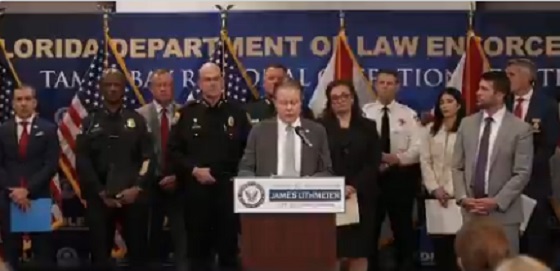Crime
Veteran RCMP Investigator Warns of Coordinated Hybrid Warfare Targeting Canada

 Sam Cooper
Sam Cooper
Central to this strategy is fentanyl—a substance whose reach now extends far beyond Canadian borders.
Fentanyl overdoses. Dirty money flooding real estate. Election interference. Foreign-backed antisemitism igniting across Canadian campuses. These are not isolated crises, warns Calvin Chrustie, a veteran RCMP national security and transnational crime investigator. They are interlinked weapons in an accelerating campaign of hybrid warfare targeting Canada—one that is hollowing out state institutions, fracturing social cohesion, and damaging our alliances. In the view of Chrustie, like other North American experts recently interviewed by The Bureau, adversarial regimes are exploiting Canada’s systemic vulnerabilities to destabilize the country from within, with consequences extending into the United States, Australia, the United Kingdom, Taiwan, Japan, and beyond.
In a sweeping interview with the Macdonald-Laurier Institute, Chrustie laid out a sobering account of how foreign states—chiefly China and Iran—are combining their intelligence capabilities with organized crime networks and proxies such as Mexican cartels to exploit Canadian systems. The Bureau has analyzed Chrustie’s comments and connected them to broader findings in its investigations into transnational crime and state-sponsored influence operations.
At the heart of Chrustie’s warning is a shift in how adversaries like China and Iran operate. No longer relying solely on spies or cyberattacks, they are weaponizing organized crime—leveraging fentanyl trafficking, corruption, and influence operations to destabilize democracies.
“Hybrid warfare is the blending of military and non-military means to weaken or destabilize a target,” Chrustie explained. “For hostile states, transnational crime is a tool—just like cyberattacks or disinformation. China, Russia, Iran, North Korea—the CRINKs—use TOC to raise money, create chaos, and undermine our institutions. TOC is no longer just criminal—it’s geopolitical.”
Fentanyl, in this context, is not only a public health catastrophe but a deliberate weapon.
“It’s about destabilizing communities, overwhelming public services, and hollowing out social cohesion,” he said. “Just like the Soviets used propaganda and the KGB used disinformation, modern adversaries use drugs, money laundering, and crime networks to erode their adversaries from within.”
This erosion now extends beyond physical harms into the social and political realm. Chrustie pointed to radical protest movements and the rise in antisemitic incidents on Canadian campuses as evidence of convergence between TOC and foreign influence operations.
“These aren’t disconnected trends,” he said. “The same threat actors behind fentanyl and money laundering are often involved in radicalization efforts. Iranian networks, for example, have long been tied to money laundering and extremist financing. And those networks are not operating in isolation. They’re aligned with China and the Mexican cartels.”
Chrustie argued that radical activism and identity-based polarization are being amplified not just by ideology, but by illicit foreign-backed financing and digital manipulation. “We’re talking about convergence,” he said. “These networks exploit every vulnerability—from public health to political discourse. Failing to connect the dots between TOC, extremism, and foreign interference means we’re always reacting too late.”
Central to this strategy is fentanyl—a substance whose reach now extends far beyond Canadian borders. “There’s no denying the scale of fentanyl production in Canada. It far outpaces our internal consumption,” he said. “We know Canadian labs are supplying Australia in large quantities. And we don’t know how much is crossing into the U.S.—because we’re not meaningfully tracking it. That lack of visibility alone is a serious national security concern.”
Seizures at the border are not the solution, Chrustie argued, because they’re not the full picture. “The U.S. has robust systems for this. Canada doesn’t,” he said. “So pointing to low seizures as proof of safety is misleading—it really just tells us what we’re not seeing.”
And what we’re not seeing, he says, includes deeply compromised infrastructure. “They exploit Canada’s weaknesses, especially in places like Vancouver, where strategic assets such as ports, shipping companies and supply chain infrastructure are key hybrid warfare targets,” he said. “The intent is to target North America through Vancouver-based assets, because it’s a lower-risk operating environment.”
The financial flows enabling this system are equally opaque—and equally dangerous. Chrustie cited the HSBC cartel laundering scandal, which led to a $1.9 billion U.S. settlement, as a historic warning that was never heeded. “The same cartel networks that emerged through the HSBC probe are engaged in Canada today,” he said.
“At one point, more encrypted communication companies linked to TOC and terrorist financers were based in Vancouver than anywhere else in the world,” he added. “These platforms were used globally—by cartels, arms traffickers, terrorists, state proxies. That tells you all you need to know about how Canada is perceived by adversaries.”
So why is Canada such a prime target? Chrustie identifies four layers of failure: strategy, structure, systems, and culture.
“We lack a cohesive, public national security strategy,” he said. “Unlike the United States or Australia, Canada doesn’t clearly define TOC as a strategic national threat. We don’t have a single, unified doctrine coordinating our federal agencies—police, intelligence, border services, foreign affairs. And TOC thrives in those gaps.”
“Our institutions are siloed,” he continued. “Policing is on the front line, but CSIS, CBSA, military and CSE aren’t always integrated. Right now, the RCMP is expected to shoulder most of the burden. But that’s unsustainable. We need an all-agency model.”
Canada’s legal and regulatory systems are another weak point. “Our legal system is designed for a domestic, rule-of-law environment. It’s ill-suited to confront global adversaries who don’t play by those rules,” Chrustie said. “Disclosure rules from Stinchcombe, Charter constraints, and evidentiary burdens mean that complex prosecutions often fall apart or never proceed.”
Finally, Chrustie warned that Canadian political culture is its most underappreciated vulnerability. “Canadians are culturally indifferent to national security,” he said. “We’ve taken a maternalistic approach—shielding the public from harsh realities, hoping to avoid panic or xenophobia. But that silence has allowed foreign actors to operate here with little resistance.”
“The historical paternalist approach of governments and bureaucrats—‘we won’t discuss these issues in public, we are the experts’—that thinking is outdated,” he said. “China, Russia, Iran and North Korea are the biggest fans of that mindset.”
Asked what a real solution looks like, Chrustie offered a sweeping and urgent framework: a national strategy naming hostile states and TOC as geopolitical threats; centralized agency coordination; intelligence-led disruption operations with allies abroad; and legal reforms enabling proactive countermeasures.
“We either need carve-outs with enhanced powers for TOC-related and foreign threat investigations—or we rely more on foreign-facing disruption efforts and accept that prosecutions are secondary,” he said.
He also emphasized grassroots engagement. “The solutions are in the communities, not in the siloed offices of governments,” Chrustie said. “We need to engage business leaders, civic organizations, educators, and diaspora communities. We need to build national resilience—not just enforce laws after the damage is done.”
His closing warning was as stark as his opening diagnosis.
“Canada is a saturated and vulnerable target,” he said. “And until we stop treating this as a criminal justice problem and start treating it as an integrated national security emergency, we will continue to lose ground.”
“There is no room for spectators.”
The Bureau is a reader-supported publication.
To receive new posts and support my work, consider becoming a free or paid subscriber.
Invite your friends and earn rewards
Crime
Suspected ambush leaves two firefighters dead in Idaho

Quick Hit:
Two firefighters were killed and another wounded Sunday after a gunman opened fire on first responders tackling a blaze near Coeur d’Alene, Idaho. The shooter was later found dead, and authorities believe the fire may have been set to lure crews into an ambush.
Key Details:
- The ambush began around 2 p.m. local time as fire crews arrived at a brush fire and were met with sniper-style gunfire from a wooded area.
- SWAT teams located the deceased suspect roughly five hours later, with a weapon nearby. His identity has not yet been released.
- The Kootenai County Sheriff said the ongoing fire could not be addressed during the gunfight, calling the attack a “heinous direct assault” on first responders.
Diving Deeper:
A deadly ambush on Sunday afternoon left two Idaho firefighters dead and a third injured after they were shot while attempting to contain a brush fire on Canfield Mountain. The surprise attack reportedly began around 2 p.m., when bullets suddenly rained down on emergency crews from hidden positions in the wooded terrain near Coeur d’Alene.
Authorities now believe the blaze may have been deliberately set as bait. Kootenai County Sheriff Bob Norris described the situation as “an active sniper attack,” saying the scene quickly escalated into chaos with gunfire coming from multiple directions.
“We don’t know if there’s one, two, three or four [shooters],” Norris said in an early evening press conference. “I’m hoping that someone has a clear shot and is able to neutralize [the suspect], because they’re not showing any signs of surrendering.”
Roughly five hours after the first shots were fired, SWAT officers found a body next to a firearm along the Canfield Mountain Trail. Authorities have not confirmed whether the individual was the sole assailant, nor have they publicly identified the person. The FBI, along with state and local agencies, had been deployed to the scene to assist with the operation.
The two firefighters who died have not yet been named. The third, who sustained a gunshot wound, was transported to Kootenai Health and remains hospitalized. His current condition is unknown.
The firefight effectively halted efforts to contain the brush fire, which remained active late into Sunday. “It’s going to keep burning. We can’t put any resources on it right now,” Norris said during the standoff. Shelter-in-place orders were issued for the surrounding area, including the popular Canfield Mountain Trailhead, but those restrictions were lifted after the suspect was found dead.
Idaho Governor Brad Little reacted to the tragedy on social media, calling the ambush “a heinous direct assault on our brave firefighters.” He added, “Teresa and I are heartbroken. I ask all Idahoans to pray for them and their families as we wait to learn more.”
Federal and local officials are continuing to investigate the incident, including the origins of the fire and whether additional suspects may have been involved.
Crime
Florida rescues 60 missing kids in nation’s largest-ever operation

Quick Hit:
Florida authorities have recovered 60 “critically missing” children in a two-week operation across the Tampa Bay area. The joint state and federal effort, dubbed Operation Dragon Eye, led to eight arrests and uncovered new human trafficking investigations.
Key Details:
-
The children, aged 9 to 17, were found across Hillsborough, Pinellas, and Pasco counties. The operation was carried out with help from the U.S. Marshals, state prosecutors, and local police departments.
-
Florida Attorney General James Uthmeier confirmed eight individuals were arrested on charges including human trafficking, child endangerment, and drug-related offenses. Additional investigations are underway.
-
The Florida Department of Law Enforcement (FDLE) hailed the operation as the most successful child recovery effort in U.S. history, declaring, “Florida doesn’t look the other way — we hunt predators and bring kids home.”
🚨 MAJOR BREAKING: U.S. Marshals and Florida officials announce LARGEST single child rescue operation in American history.
Over 2 weeks, 60 KIDS are safe, in custody.
This involved over 20 agencies and 100+ people. 8 people were arrested, charged with human trafficking, child… pic.twitter.com/trkcFMhtmX
— Eric Daugherty (@EricLDaugh) June 23, 2025
Diving Deeper:
Over a two-week span, law enforcement agencies across Florida joined forces for what’s being called a historic child recovery mission. Dubbed Operation Dragon Eye, the coordinated effort led to the rescue of 60 critically missing children—some as young as 9 years old—in the Tampa Bay region, including Hillsborough, Pinellas, and Pasco counties.
According to Fox 13, federal and state agencies worked alongside local law enforcement, with direct involvement from the U.S. Marshals Service and Florida prosecutors. The term “critically missing,” as defined by the Marshals Service, applies to minors facing heightened threats such as exposure to violent crime, sexual exploitation, substance abuse, or domestic violence.
Florida Attorney General James Uthmeier praised the operation’s success in a statement posted to social media Monday. “We will keep fighting evil head-on and bringing accountability to those who harm children,” he said, confirming eight suspects had been taken into custody, with additional investigations now underway related to human trafficking networks.
Charges filed against the arrested individuals include human trafficking, child endangerment, custodial interference, and drug possession.
The Florida Department of Law Enforcement described the effort as “the most successful missing child recovery operation in American history.” In a statement, the agency said its analysts and field agents “were proud to stand shoulder to shoulder with the U.S. Marshals” and emphasized that “Florida doesn’t look the other way.”
Several nonprofits and local support groups played a vital role in caring for the recovered children, including More Too Life, the Children’s Home Network, Bridging Freedom, Bridges of Hope, Family Support Services of Pasco and Pinellas, and Redefining Refuge.
Dr. Katherine Gomez of the Florida Department of Juvenile Justice said many of these children had felt hopeless and alone. “Oftentimes these young people have felt like there’s no one in their corner. They feel abandoned… like they have to look out for themselves because no one else will,” she told WFLA.
FDLE Commissioner Mark Glass acknowledged the emotional toll such operations take on officers, who are exposed to the trauma these children endure. “They have to see everything that happens to these children, and we need to pray for them because they had to take that burden home,” he said.
Glass added that while the operation struck a major blow to human trafficking in the region, the threat remains. “The fight isn’t over.”
U.S. Marshal Bill Berger of the Middle District of Florida warned that traffickers often return to their victims if not apprehended. “If the offenders are not apprehended, they will reconnect with these children. They are, in my opinion, leeches,” Berger stated.
Officials vowed continued vigilance to keep predators behind bars and ensure every vulnerable child is found and protected.
-

 Brownstone Institute2 days ago
Brownstone Institute2 days agoFDA Exposed: Hundreds of Drugs Approved without Proof They Work
-

 Energy1 day ago
Energy1 day agoChina undermining American energy independence, report says
-

 Business1 day ago
Business1 day agoTrump on Canada tariff deadline: ‘We can do whatever we want’
-

 Automotive1 day ago
Automotive1 day agoElectric vehicle sales are falling hard in BC, and it is time to recognize reality.
-

 Business1 day ago
Business1 day agoEurope backs off greenwashing rules — Canada should take note
-

 Automotive1 day ago
Automotive1 day agoPower Struggle: Electric vehicles and reality
-

 Business5 hours ago
Business5 hours agoCanada Caves: Carney ditches digital services tax after criticism from Trump
-

 Business4 hours ago
Business4 hours agoMassive government child-care plan wreaking havoc across Ontario







